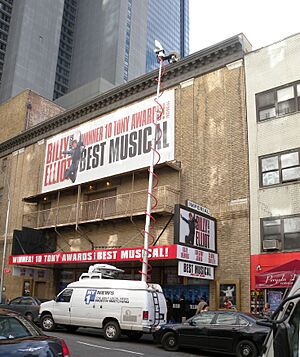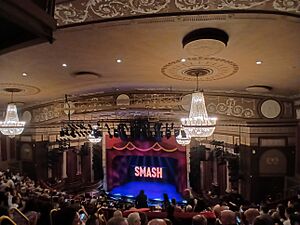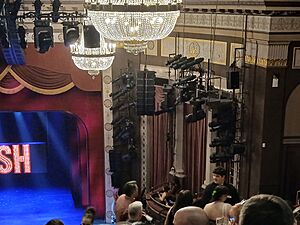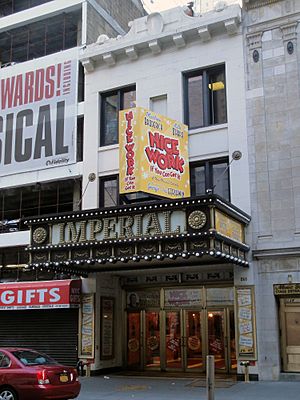Imperial Theatre facts for kids
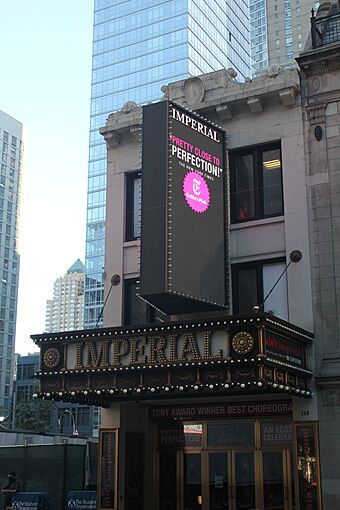
The 45th Street entrance as seen in October 2021
|
|
| Address | 249 West 45th Street Manhattan, New York United States |
|---|---|
| Coordinates | 40°45′33″N 73°59′14″W / 40.759190°N 73.987120°W |
| Owner | The Shubert Organization |
| Type | Broadway |
| Capacity | 1,457 |
| Construction | |
| Opened | December 25, 1923 |
| Architect | Herbert J. Krapp |
| Designated | November 17, 1987 |
| Reference no. | 1343 |
| Designated entity | Auditorium interior |
The Imperial Theatre is a famous Broadway theater located at 249 West 45th Street in the Theater District of Midtown Manhattan, New York City. It first opened its doors in 1923. The theater was designed by Herbert J. Krapp and built for the Shubert brothers. It has 1,457 seats spread across two levels. Today, The Shubert Organization operates the theater. The inside of the theater, called the auditorium, is a special New York City designated landmark.
The theater building is mostly on 46th Street. A long, narrow hallway leads to the main entrance on 45th Street. This entrance has a three-story front made of white terracotta, which is a type of baked clay. The 46th Street side of the building is made of light brown brick. This side was originally meant for carriages to drop off visitors. The lobby, which used to have dark and white tiles, leads to the back of the main seating area. The auditorium has fancy decorations in a style called Adam-style. It features a large balcony and special box seats with carved designs above them. Above the stage, there is a flat arch called a proscenium arch, with a curved "sounding board" above it to help the sound travel.
The Imperial Theatre was the fiftieth theater built by the Shubert Organization in New York City. It was constructed in 1923 to replace an older theater. The Imperial officially opened on December 25, 1923, with the musical Mary Jane McKane. Since then, it has been home to many popular and long-running musicals. These include Annie Get Your Gun, Fiddler on the Roof, Dreamgirls, Les Misérables, and Billy Elliot the Musical. The Imperial has also shown plays, with Chapter Two being the longest-running play at this theater.
Contents
Where is the Imperial Theatre Located?
The Imperial Theatre is at 249 West 45th Street in Midtown Manhattan, New York City. It is on the north side of the street, between Eighth Avenue and Broadway. This area is part of the famous Theater District, close to Times Square. The land the theater sits on is about 13,350 square feet. The part of the theater on 45th Street is narrower than the main part on 46th Street, where the stage and most seats are.
The part of 45th Street where the Imperial Theatre is located is also known as George Abbott Way. Many people walk on this street, which helps theaters sell more tickets. The Imperial Theatre shares its block with other famous theaters like the Richard Rodgers Theatre and the Music Box Theatre. Other nearby buildings include the Paramount Hotel and the Lena Horne Theatre. The land for the theater was once part of the Astor family's large property, which they bought in 1803.
Who Designed the Imperial Theatre?
The Imperial Theatre was designed by Herbert J. Krapp and built in 1923 for the Shubert brothers. It was the 50th theater the Shuberts built in the New York area. The O'Day Construction Company built the theater, with many other companies helping out. Today, The Shubert Organization still runs the Imperial.
The Outside Look of the Theater
The theater has a narrow section that reaches south to 45th Street, but the main part of the building is on 46th Street. The main entrance is on 45th Street and has a white terracotta front. This entrance building is three stories tall. It is very narrow because it was built between two other theaters. The design of this front is quite simple, except for the signs. This simple style was common for theaters Krapp designed for the Shuberts after World War I.
The back of the theater, which faces 46th Street, is made of light brown brick. This side is much wider and was used for carriages to drop off and pick up people. This helped reduce traffic on 45th Street. The 46th Street side has a special brick pattern. A stage door is located on the eastern side of this facade, next to the Richard Rodgers Theatre.
Inside the Auditorium
The auditorium, or main seating area, has a main floor (orchestra level), one balcony, and special box seats. The stage is behind a large arch called the proscenium arch. The auditorium is wider than it is deep. It is decorated with fancy plaster designs that stick out from the walls. The Shubert Organization says the theater has 1,457 seats. Other sources give slightly different numbers, but it's around 1,400 seats. The seats are divided into sections: 759 on the orchestra level, 283 in the front balcony, 377 in the rear balcony, and 20 in the box seats. There are also 18 seats in the orchestra pit right in front of the stage. The theater was first built with 1,650 seats. The design style is mostly Adam style, which is a classical style with elegant decorations.
Seating Areas and Decorations
A 20-foot-wide hallway from the 45th Street entrance leads to a wide area at the back of the orchestra level. This hallway originally had light and dark tiled floors and marble walls. Now, the marble is a different color. The orchestra area has two columns with fancy tops and a decorated ceiling. Two staircases lead from this area up to the balcony. The orchestra floor slopes down towards the stage, and the side walls curve inwards. The lower parts of the side walls are paneled, with more panels above. Exit doors leading to 46th Street are on the left wall. The seating is arranged in a wide, fan shape to make sure the sound is good for everyone.
A walkway divides the balcony into front and back sections. The balcony's side walls have flat columns that create arched sections. These sections have panels with carved pictures of dancing figures and doorways with Adam-style decorations. The balcony walls are topped with a decorative border and a molding. The front railing of the balcony is plain. The underside of the balcony, above the orchestra, has detailed paneling.
On each side of the stage, there are three box seats on the balcony level. These boxes step down towards the stage. The theater used to have box seats on the orchestra level too, but they were removed. The front of the boxes curve outwards and have molded designs. Each set of boxes is placed in a rectangular opening, divided by two eight-sided columns. These openings are surrounded by plaster designs of leaves and shapes. Above these openings are rectangular plaster panels with images of winged fairy-like figures holding theater masks that represent comedy and tragedy.
Other Cool Design Features
Next to the box seats is a flat proscenium arch, which frames the stage. This archway is surrounded by plaster designs of flowers. On each side of the archway are flat columns with decorative tops. The decorative border and molding from the balcony continue above the arch. The proscenium arch is about 25 feet high and nearly 40 feet wide. The distance from the back of the auditorium to the stage is about 40 feet.
A sounding board is on the ceiling above the proscenium arch. This board has a decorative band with leaf designs and a patterned panel in the middle. The rest of the ceiling curves slightly. This design was meant to make the theater feel cozy and personal. The ceiling is a bit higher than the sounding board, creating a raised section near the front of the auditorium. This section has Adam-style plaster decorations and round medallions. The rest of the ceiling has panels with decorative borders and medallions in the center. Chandeliers used to hang from these ceiling panels. Today, the ceiling has new chandeliers and air conditioning vents.
History of the Imperial Theatre
The area around Times Square became the main place for big theater shows between 1900 and the Great Depression. During the early 1900s, many theaters in Midtown Manhattan were built by the Shubert brothers. They were a major group in the theater world. By 1925, the Shubert brothers controlled a quarter of all plays and three-quarters of theater ticket sales in the U.S. The Shuberts had used the Lyric Theatre for their musicals since 1903, but they needed a new one because the Lyric was getting old.
Building and Early Shows
The Shubert brothers decided to buy land on both 45th and 46th Streets. The 45th Street side was more popular because it was near other theaters, but the 46th Street land was cheaper. The Shuberts hired Herbert Krapp to design the new theater in January 1923. The Imperial Theatre got its name in December 1923, just a few weeks before it opened. The first show booked was Mary Jane McKane.
The Imperial Theatre officially opened on December 25, 1923, with the premiere of Mary Jane McKane. This musical was a hit and ran for 151 performances. In May 1924, the Moscow Art Theatre performed at the Imperial. Another popular show was the operetta Rose-Marie, which opened in September 1924 and ran for over 500 performances.
In 1926, the Imperial hosted Oh, Kay!, which featured Victor Moore and Gertrude Lawrence with music by George and Ira Gershwin. Then came Sigmund Romberg's operetta The New Moon in 1928. It was one of Broadway's last big operetta hits and ran for over 500 performances. The musical Sons o' Guns opened in November 1929 and ran for 297 performances, even though the Great Depression had just started.
From the 1930s to the 1950s
The 1930s started with some shorter shows, but the Imperial still had several successful productions despite the Shuberts' money problems during the Depression. Ed Wynn performed The Laugh Parade in 1931. In 1933, the theater showed two plays by George S. Kaufman and Morrie Ryskind: Of Thee I Sing and Let 'Em Eat Cake. The Imperial hosted the musicals Say When in 1934 and Jubilee in 1935. These were followed by the ballet-themed On Your Toes in 1936.
More successful shows in the late 1930s included Cole Porter's Leave It to Me! in 1938, which was Mary Martin's first Broadway show. Also popular was Too Many Girls in 1939 by Richard Rodgers and Lorenz Hart. The Imperial continued to host popular musicals throughout the 1940s. These included Louisiana Purchase in 1940, which ran for 444 performances, and Let's Face It! in 1941, which ran for 547 performances. The musical One Touch of Venus premiered in 1943 with Mary Martin.
The late 1940s and 1950s brought many more hits. The biggest was the musical Annie Get Your Gun, starring Ethel Merman, which opened in 1946 and ran for 1,147 performances. In 1950, the Imperial hosted Peter Pan, and later that year, Ethel Merman returned in Call Me Madam, which ran for 644 performances.
Wish You Were Here opened in 1952 and ran for 598 performances. Its stage even had a working swimming pool! This was followed by John Murray Anderson's Almanac in 1953. The Imperial staged Silk Stockings in 1955, which was Cole Porter's last Broadway show. The musical The Most Happy Fella opened in 1956. The Imperial also hosted Jamaica in 1957, starring Lena Horne, and Destry Rides Again in 1959, starring Dolores Gray and Andy Griffith.
From the 1960s to the 1980s
The Imperial had more long-running shows in the 1960s. Gypsy with Ethel Merman moved to the Imperial in 1960. Next was Carnival!, which opened in 1961. Carnival! closed to make way for Oliver!, a musical from London that opened at the Imperial in 1963. Oliver! ran for a year and a half. After that, Fiddler on the Roof opened in 1964. Fiddler, starring Zero Mostel, stayed for almost three years. This was followed in 1967 by Cabaret, which ran for a year and a half.
In 1970, the Imperial hosted the musical Minnie's Boys and Two By Two, starring Danny Kaye. Then came the musical Pippin in 1972, which ran for over four years. During that time, the Imperial hosted the 27th Tony Awards in 1973. By the late 1970s, it became more expensive to produce Broadway musicals, so the Imperial had fewer of them. In 1977, the Imperial showed Neil Simon's play Chapter Two. With 857 performances, Chapter Two became the Imperial's longest-running non-musical show.
Most of the 1980s were dominated by a few musicals. Neil Simon's They're Playing Our Song opened in December 1979 and ran for over two and a half years. The next big show was the musical Dreamgirls, starring Jennifer Holliday, which opened at the end of 1981. Dreamgirls ran for 1,522 performances over four years. The 1982 Tony Awards were held at the Imperial during the run of Dreamgirls. The next production was The Mystery of Edwin Drood, which opened in 1985 and ran for two years. The Imperial's last shows of the 1980s included a return of Cabaret in 1987, Chess in 1988, and Jerome Robbins' Broadway in 1989. In the late 1980s, the Shuberts updated the Imperial as part of a plan to restore their Broadway theaters.
The New York City Landmarks Preservation Commission started thinking about protecting the Imperial as a landmark in 1982. On November 17, 1987, they officially named only the inside of the theater as a landmark. This was part of a bigger effort to protect many Broadway theaters. The Shuberts and other theater owners tried to stop these landmark designations in court, but the designations were upheld in 1992.
From the 1990s to Today
Jerome Robbins' Broadway closed in 1990. Les Misérables moved to the Imperial in late 1990 and played there for the next ten years. Les Misérables was one of the longest-running Broadway shows ever when it closed in 2003. The next show was The Boy from Oz, which opened in 2003 and ran for almost a year. In 2003, the Shuberts agreed to make their theaters, including the Imperial, more accessible for people with disabilities. This was followed by Dirty Rotten Scoundrels in 2005, and August: Osage County in 2007.
Billy Elliot the Musical opened in November 2008 and ran for over three years. It was followed by Nice Work If You Can Get It in 2012, and a return of Les Misérables in 2014. Natasha, Pierre & The Great Comet of 1812 opened in 2016, and Carousel in 2018. In 2019, the musical Ain't Too Proud opened. This show set a new box office record for the Imperial Theatre, earning over $1.8 million in one week in December 2019.
The theater closed on March 12, 2020, because of the COVID-19 pandemic. It reopened on October 16, 2021, with performances of Ain't Too Proud, which ran until January 2022. The Imperial's next show, Andrew Lloyd Webber's musical Bad Cinderella, opened in March 2023 and closed that June. This was followed in March 2024 by the musical Water for Elephants, which closed in December 2024. Smash, a musical based on the TV series, opened at the theater in April 2025. A new production of Chess is expected to open at the Imperial Theatre in November 2025.
Notable Productions
Here are some of the famous shows that have played at the Imperial Theatre, listed by the year they first opened.
| Opening year | Name | Refs. |
|---|---|---|
| 1923 | Mary Jane McKane | |
| 1924 | Rose-Marie | |
| 1926 | Oh, Kay! | |
| 1927 | The Desert Song | |
| 1928 | The New Moon | |
| 1930 | Princess Charming | |
| 1930 | Babes in Toyland | |
| 1932 | Flying Colors | |
| 1933 | Of Thee I Sing | |
| 1933 | Let 'Em Eat Cake | |
| 1934 | Say When | |
| 1935 | Panic | |
| 1935 | Jubilee | |
| 1936 | On Your Toes | |
| 1936 | Hamlet | |
| 1937 | Between the Devil | |
| 1938 | You Can't Take It with You | |
| 1938 | Leave It to Me! | |
| 1939 | Too Many Girls | |
| 1940 | Louisiana Purchase | |
| 1941 | Let's Face It! | |
| 1943 | One Touch of Venus | |
| 1943 | Ziegfeld Follies | |
| 1944 | Song of Norway | |
| 1946 | Annie Get Your Gun | |
| 1949 | Miss Liberty | |
| 1950 | Peter Pan | |
| 1950 | Call Me Madam | |
| 1952 | Wish You Were Here | |
| 1953 | John Murray Anderson's Almanac | |
| 1954 | By the Beautiful Sea | |
| 1955 | Silk Stockings | |
| 1956 | The Most Happy Fella | |
| 1957 | Jamaica | |
| 1959 | Destry Rides Again | |
| 1960 | Gypsy | |
| 1961 | Carnival! | |
| 1963 | Oliver! | |
| 1964 | Fiddler on the Roof | |
| 1967 | Cabaret | |
| 1968 | Zorba | |
| 1969 | A Patriot for Me | |
| 1970 | Minnie's Boys | |
| 1970 | Two by Two | |
| 1971 | On the Town | |
| 1972 | Lost in the Stars | |
| 1972 | Pippin | |
| 1977 | Mark Twain Tonight! | |
| 1977 | Anna Christie | |
| 1977 | Chapter Two | |
| 1979 | They're Playing Our Song | |
| 1981 | Dreamgirls | |
| 1985 | The Mystery of Edwin Drood | |
| 1987 | Cabaret | |
| 1988 | Chess | |
| 1989 | Jerome Robbins' Broadway | |
| 1990 | Les Misérables | |
| 2003 | The Boy from Oz | |
| 2005 | Dirty Rotten Scoundrels | |
| 2006 | High Fidelity | |
| 2007 | Coram Boy | |
| 2007 | August: Osage County | |
| 2008 | Billy Elliot the Musical | |
| 2012 | Nice Work If You Can Get It | |
| 2013 | 700 Sundays | |
| 2014 | Les Misérables | |
| 2016 | Natasha, Pierre & The Great Comet of 1812 | |
| 2018 | Carousel | |
| 2018 | Ruben & Clay's First Annual Christmas Carol Family Fun Pageant Spectacular Reunion Show | |
| 2019 | Ain't Too Proud | |
| 2023 | Bad Cinderella | |
| 2024 | Water for Elephants | |
| 2025 | Smash |
See Also
- List of Broadway theaters
- List of New York City Designated Landmarks in Manhattan from 14th to 59th Streets


